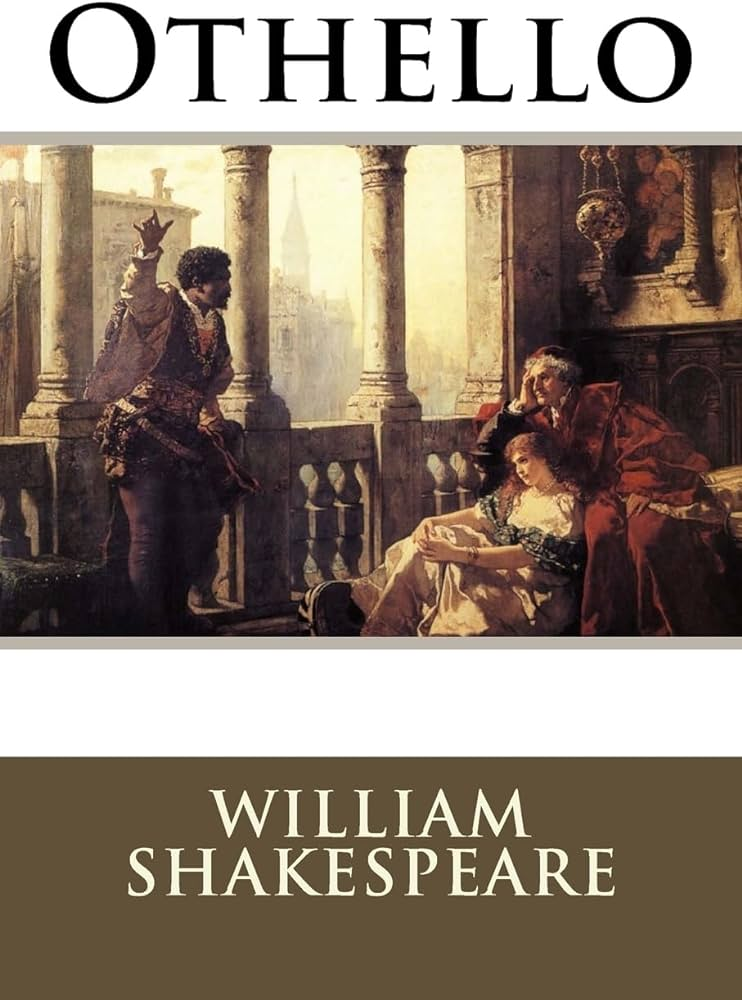Hello Readers! In this post, I am going to discuss the tragic play 'Othello' written by William Shakespeare.
'Othello':
The tragic play Othello was written by William Shakespeare in 1603-1604. The play was written in five acts and deals with the themes of passion, jealousy, deception, and race. The play's plot comes from the Italian drama De gli Hecatommithi (1565) written by Giambattista Giraldi.
"Othello" is a tragedy by William Shakespeare set in Venice, Italy. The play follows the Moorish general Othello, who secretly marries Desdemona, a Venetian noblewoman. Othello promotes Cassio, a younger officer, over his ensign Iago, which triggers Iago's jealousy and resentment. Iago manipulates Othello into believing that Desdemona has been unfaithful with Cassio, exploiting Othello's insecurities about his race and age. As Othello's jealousy intensifies, he becomes consumed by doubts and suspicions, leading to tragic consequences. In a fit of rage, Othello kills Desdemona, believing she has betrayed him. The truth eventually comes to light, exposing Iago's deceit and manipulation. Devastated by his actions and the realization of his mistake, Othello takes his own life. The play delves into themes of jealousy, deception, betrayal, racism, and the fragility of human relationships, showcasing the tragic consequences of unchecked emotions and manipulation.
William Shakespeare:
William Shakespeare was a famous writer from England. He was born in 1564 and died in 1616. He wrote many plays, poems, and sonnets that people still love today. His stories talk about love, power, and many other feelings. He wrote different types of plays like sad ones, funny ones, and ones about history. Even though he didn't go to a fancy school, he was really good at writing and telling stories. People all around the world still perform his plays and study his work because he had a special way with words and understanding people. Shakespeare is considered one of the best writers ever.
Othello as Tragic Hero:
Othello is often regarded as a classic tragic hero in literature. In Shakespeare's play "Othello," he embodies many of the characteristics typical of tragic heroes:
1. Noble Birth or High Status: Othello is a respected and esteemed general in the Venetian army, commanding the respect of his troops and the admiration of the Venetian Senate.
2. Tragic Flaw (Hamartia): Othello's tragic flaw is his susceptibility to jealousy and his tendency to believe the worst about those he loves. This flaw is manipulated by the villainous Iago, leading to Othello's downfall.
3. Reversal of Fortune (Peripeteia): Othello experiences a reversal of fortune as a result of his tragic flaw. He goes from being a confident and respected leader to a man consumed by jealousy and suspicion, ultimately leading to his own destruction.
4. Recognition of Error (Anagnorisis): Othello experiences a moment of realization and self-awareness near the end of the play when he discovers the truth about Desdemona's innocence and Iago's treachery. However, it comes too late to save him from his tragic fate.
5. Hubris: Othello's downfall is also fueled by his pride and sense of honor. He believes that he alone can control the situation and refuses to listen to reason, leading to his tragic demise.
6. Catharsis: The audience experiences catharsis as they witness Othello's downfall and are moved to pity and fear by his tragic fate. His story serves as a cautionary tale about the destructive power of jealousy and the consequences of unchecked emotions.
In short, Othello's journey from a noble and respected leader to a tragic figure consumed by jealousy and suspicion epitomizes the characteristics of a tragic hero. His story continues to resonate with audiences as a timeless exploration of human nature and the complexities of the human psyche.
symbols and motifs in Play:
In "Othello," William Shakespeare employs various symbols and motifs to deepen the themes and enhance the dramatic impact of the play. Here are some key symbols and motifs:
1. Handkerchief:
Desdemona's handkerchief, given to her by Othello as a token of his love, becomes a significant symbol in the play. It represents fidelity, love, and innocence. However, when Iago manipulates Othello into believing that Desdemona has given it to Cassio as a token of her affection, the handkerchief transforms into a symbol of betrayal and deception.
2. Animals:
Throughout the play, characters use animal imagery to dehumanize and degrade one another. Iago frequently compares Othello to animals such as a "Barbary horse" or a "black ram," portraying him as bestial and uncivilized. This motif highlights the theme of dehumanization and underscores the racial prejudice faced by Othello.
3. The Willow Song:
Desdemona's song about a woman betrayed by her lover serves as a haunting motif throughout the play. It foreshadows Desdemona's fate and emphasizes the theme of betrayal and unfaithfulness in relationships.
4. The Handkerchief Song:
Emilia's cynical song about the fickleness of men and the insignificance of fidelity serves as a thematic counterpoint to Desdemona's Willow Song. It reflects the play's exploration of gender roles, power dynamics, and the complexities of love and trust.
5. Green Colour:
The motif of the color green in "Othello" symbolizes jealousy and envy, particularly highlighted in Iago's warning to Othello about the "green-eyed monster." This metaphor underscores the destructive nature of jealousy, both in Iago's envy of Othello and Othello's escalating suspicion towards Desdemona. As the play progresses, the color green becomes a visual representation of Othello's growing paranoia and vulnerability to manipulation. Ultimately, Othello's jealousy, depicted through the color green, leads to tragic outcomes, emphasizing the theme of jealousy as a destructive force in the play.
''O, beware my lord of jealousy./It is the green-eyed monster which doth mock/The meat it feeds on. ' Iago begins to turn Othello against the 'worthy' Cassio and Desdemona."
These symbols and motifs contribute to the thematic richness and dramatic intensity of "Othello," underscoring themes of love, jealousy, betrayal, race, and the human condition.
Major Themes in Othello:
The play Othello is a domestic tragedy and involves happening of individual characters. The themes in Othello are linked with individual characters ranging from hatred to love, jealousy to revenge, service to betrayal, and innocent to guilty. Major themes In Othello are love, jealousy, racial prejudice, appearance versus reality, expectations versus outcome and intrigue.
Love:
Love is the main theme of the play but unluckily the web of intrigues spoils it very badly. Love is the main driving force of the play surrounded by other themes. We can see different types of love in the play: Desdemona’s love for Othello, Othello’s love for Desdemona, Emilia’s love for her mistress, Desdemona’s love for her maid, Desdemona’s affections for Cassio, Iago’s love for money, Roderigo’s love for Desdemona, are the few examples of the love in the play. Othello and Desdemona's marriage is based on real love, but Othello starts to doubt Desdemona's love because of lies from a guy named Iago. Othello is great at winning battles, but he fails at love. Iago tricks him easily because Othello trusts him too much. Desdemona's friendship with Cassio is real, but Othello gets jealous and thinks it's something more. Emilia, Desdemona's maid, is a true friend. She even stands up for Desdemona against her own husband, Iago, and gets killed for it. Iago says he loves Desdemona too, but his love is fake. He's really just using love to get what he wants, like money or power. Love in "Othello" can be real and strong, but it can also be twisted and used for bad things.
Jealousy:
The downfall of Othello is indeed rooted in jealousy, as manipulated by Iago. Iago himself describes jealousy as a dangerous monster, feeding on the very emotions it stirs up. However, what Iago fails to realize is that the jealousy he ignites in Othello far surpasses his own. Othello's jealousy becomes like a raging storm, impossible to escape from. It centers on the belief that his wife, Desdemona, has been unfaithful with Cassio, and no amount of reassurance can calm his suspicions. Othello's jealousy becomes so overwhelming that he ultimately kills Desdemona, his own beloved wife. Iago takes advantage of every opportunity to stoke Othello's jealousy, fabricating lies and manipulating them into reality. However, he remains unaware of the true extent of the devastation his actions will cause.
Appearance versus Reality:
The theme of appearance versus reality is deeply explored in "Othello," particularly through Othello's demand for proof and his subsequent downfall. Othello's insistence on seeing proof blinds him to the truth and leads to his tragic demise. He blindly trusts Iago and believes the fabricated evidence presented to him, without questioning or seeking the reality behind it. Despite Emilia's attempts to defend Desdemona's innocence and reveal the truth, Othello refuses to believe her, instead placing unwavering trust in Iago, whom he considers a close friend. Othello's inability to discern between friend and foe, truth and falsehood, highlights his vulnerability to manipulation and deception.
Othello's perception of Cassio, Desdemona, and even himself is distorted by appearances. He fails to see Cassio's sincerity and Desdemona's loyalty, instead allowing jealousy to cloud his judgment and perception of reality. Ultimately, Othello's inability to distinguish between appearance and reality leads to his tragic downfall. He becomes consumed by jealousy and unable to see the truth, resulting in the destruction of his marriage, his reputation, and ultimately, his own life. The play serves as a cautionary tale about the dangers of blindly trusting appearances and the consequences of failing to discern reality from illusion.
Racism:
In "Othello," racism is a central theme explored through the character of Othello, a Moorish general in the Venetian army. Throughout the play, Othello is depicted as an outsider in Venetian society due to his African heritage. He is frequently referred to as "the Moor" and subjected to derogatory comments and stereotypes by characters like Iago and Roderigo. These characters use Othello's race as a tool to undermine his authority and manipulate those around him, highlighting the deeply ingrained racism of the time. Iago, in particular, exploits Othello's race to further his own agenda. He plays on the racist attitudes of others to sow seeds of doubt in Othello's mind about his wife, Desdemona, and his lieutenant, Cassio. By portraying Desdemona's love for Othello as unnatural and Cassio's promotion as undeserved due to his race, Iago fuels Othello's insecurities and triggers his jealousy. Othello's own internalized racism is evident as he grapples with feelings of inadequacy and alienation due to his race, making him susceptible to Iago's manipulations. Through the character of Othello and the actions of characters like Iago, Shakespeare provides a stark portrayal of the destructive power of racism and prejudice in society.
In conclusion, "Othello" delves deeply into themes of jealousy, love, racism, and appearance versus reality, providing profound insights into the human condition. Symbols like the handkerchief, the color green, and animal imagery enrich the narrative and reinforce these themes. The play confronts the pervasive racism of its time through Othello's character, emphasizing the dangers of prejudice and discrimination. In summary, "Othello" remains a timeless masterpiece, offering valuable reflections on human nature and society through its exploration of themes, symbols, and motifs.
Words - 1859








No comments:
Post a Comment